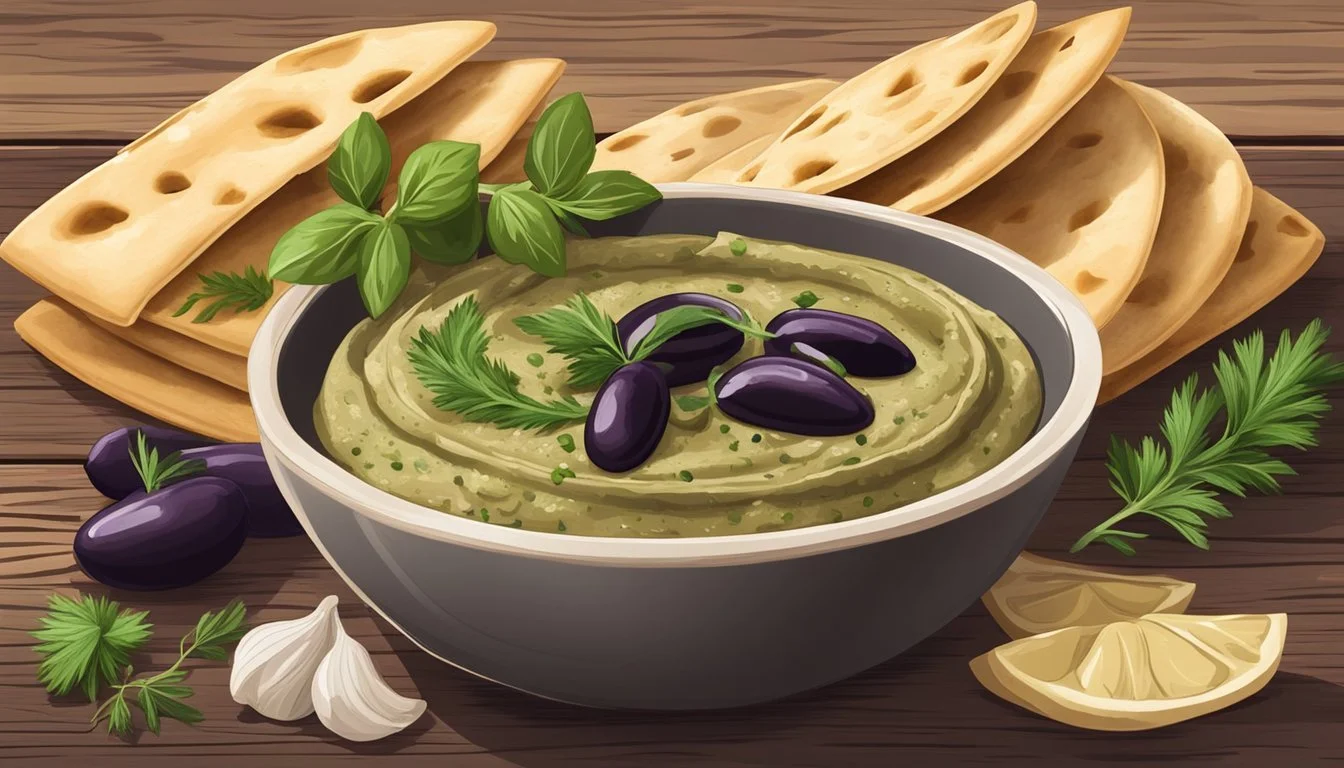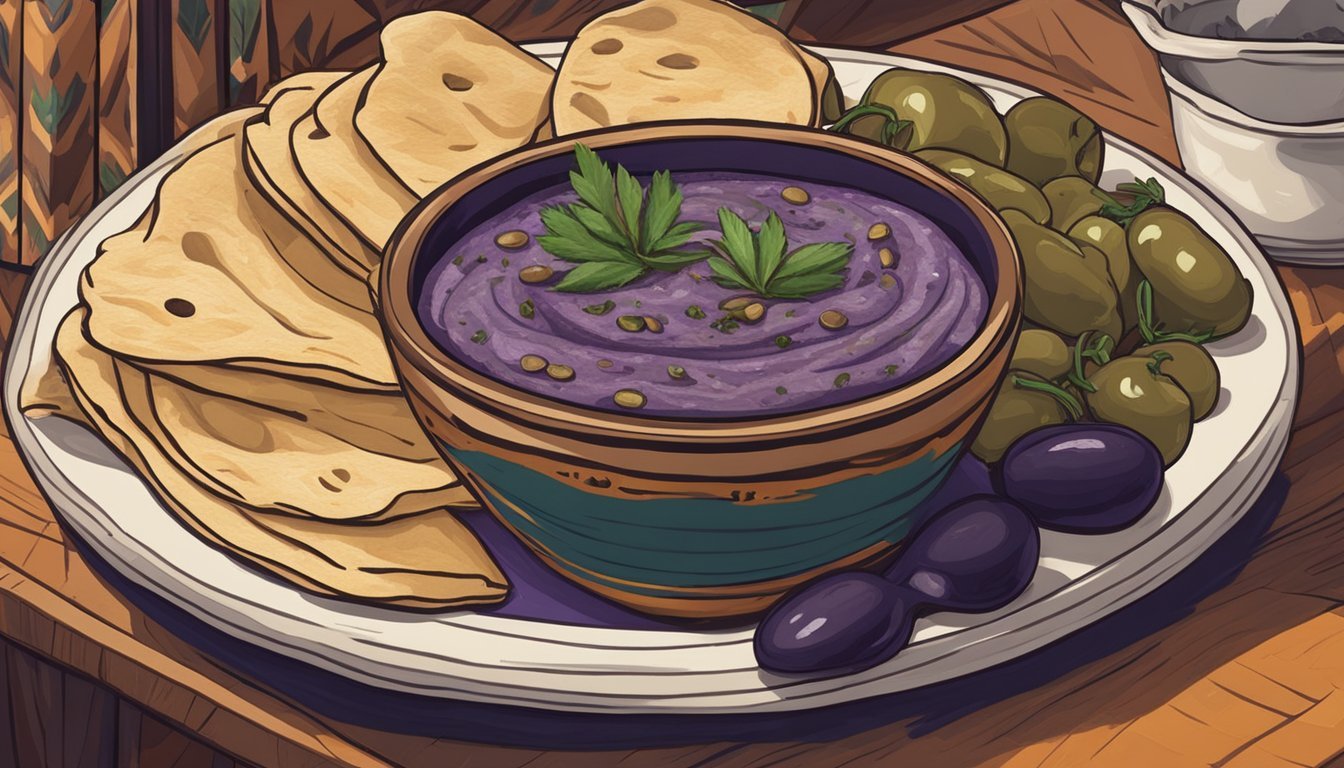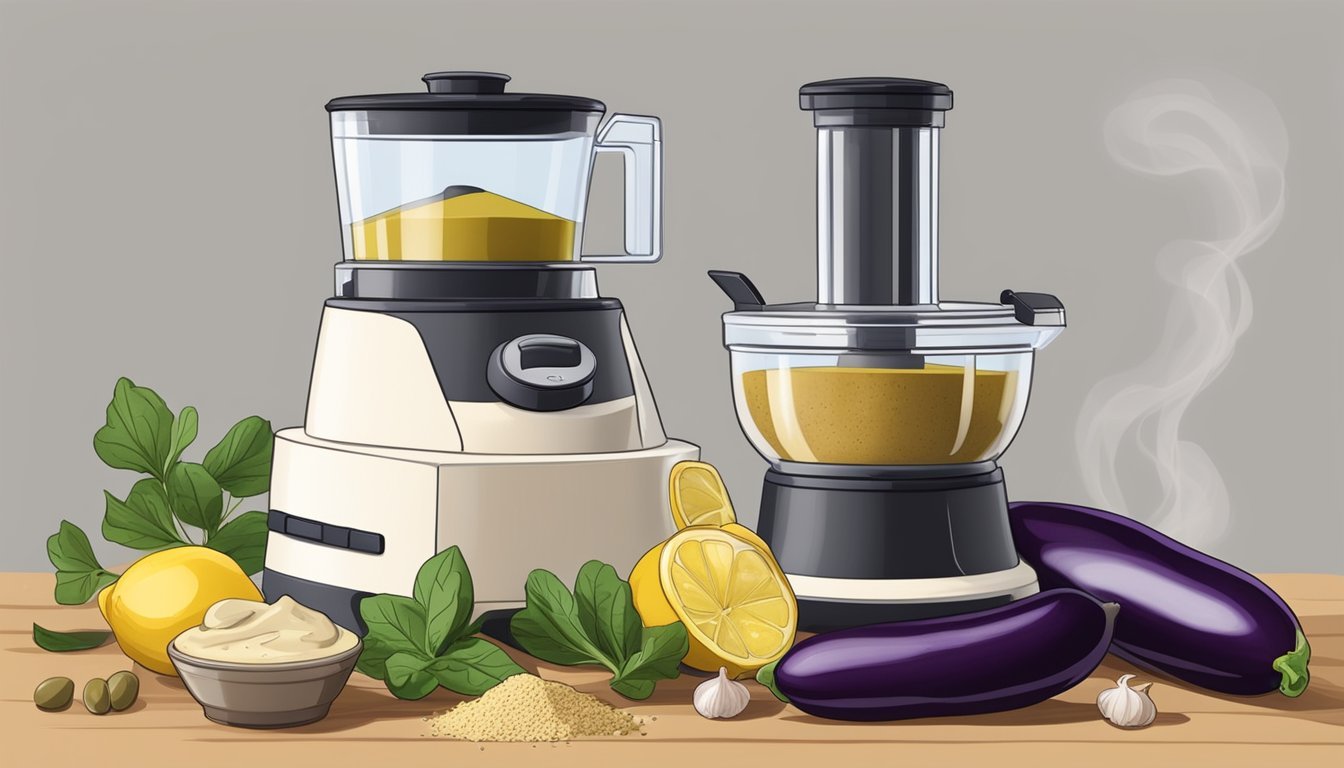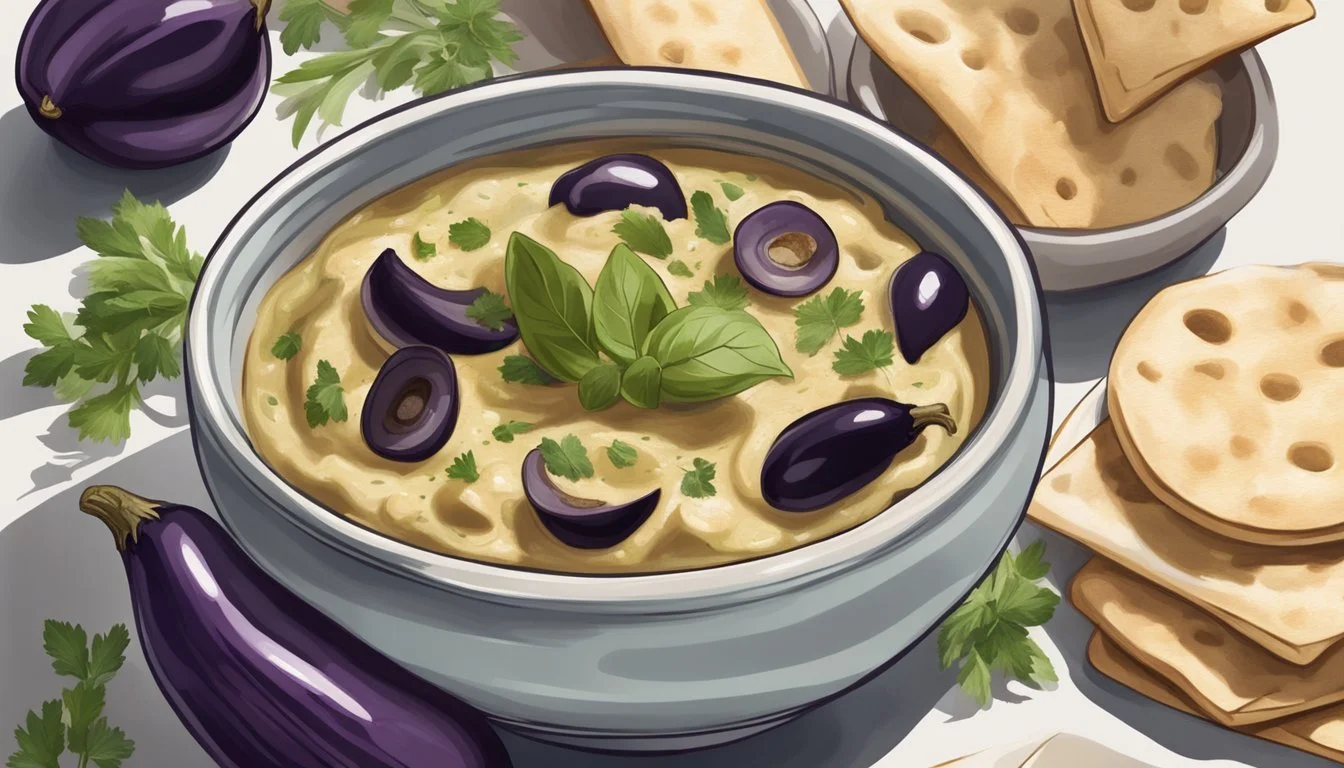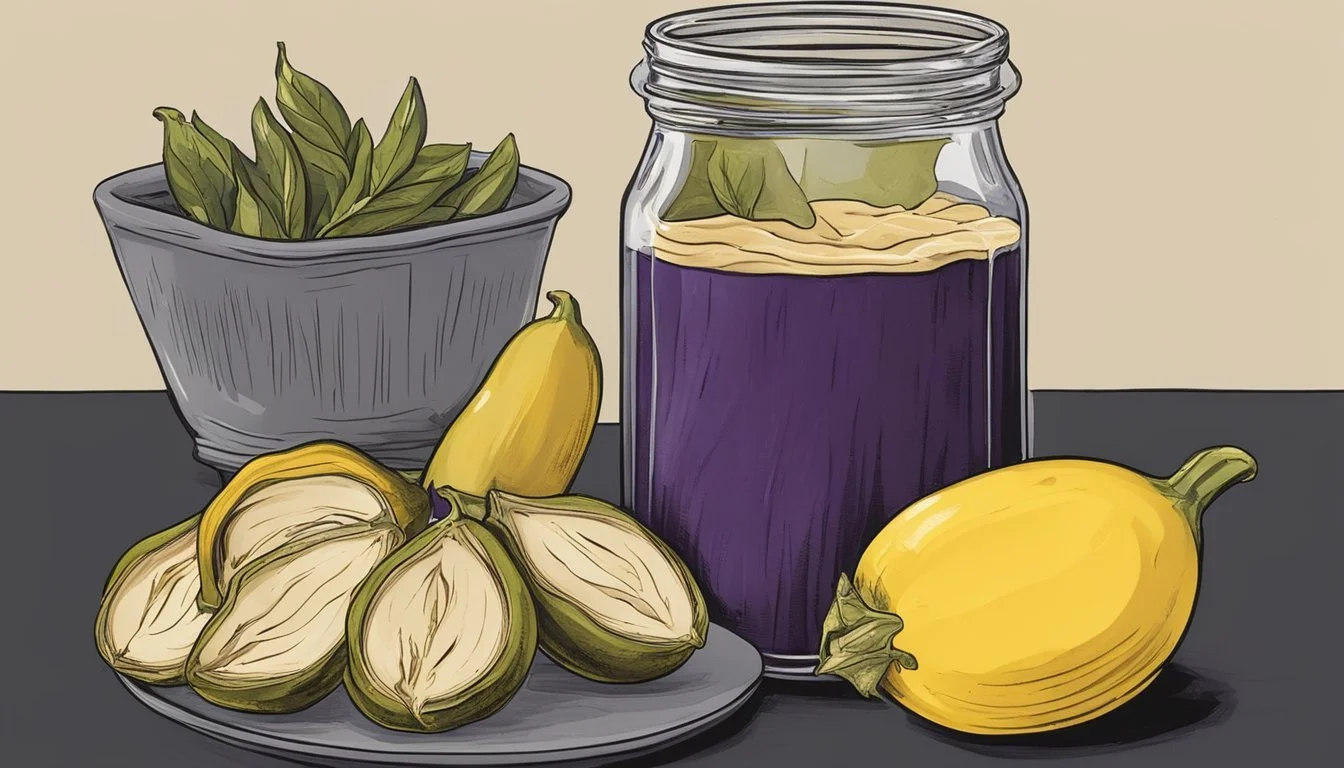Eggplant Peel Dip
A Culinary Journey into Smoky Middle Eastern Flavors
Eggplant (What wine goes well with eggplant?) Peel Dip is a sumptuous spread that has earned its place at the table in Middle Eastern cuisine. Characterized by its smoky flavor and creamy texture, this dish is often compared to baba ganoush, a staple spread in the Mediterranean diet. Unlike baba ganoush, which might see the eggplant's skin discarded, eggplant peel dip capitalizes on the rich, smoky essence of the charred skin, integrating it fully into the dip. This imparts a distinct depth of flavor revered by culinary enthusiasts.
The preparation of eggplant peel dip involves charring eggplants until their skins blacken and blister. This traditional technique, whether executed on an open flame or under a broiler, is crucial for achieving the signature smoky taste. Once cooled, the softened eggplant is combined with tahini, garlic, lemon juice, and various seasonings such as salt and sometimes yogurt to create a spread that's both tantalizing and versatile.
Middle Eastern eggplant peel dip is not only bursting with flavor but also laden with the health benefits of eggplants, which are rich in fiber, vitamins, and minerals. It's often served alongside warm pita bread, crisp vegetables or as part of a mezze platter, offering a robust option for dips that can be enjoyed in a variety of culinary settings.
History and Origin
The smoky and savory eggplant peel dip, predominantly known as Baba Ganoush, is a staple in Middle Eastern cuisine. Its journey is deeply intertwined with the diverse culinary traditions and customs of the region.
Cultural Significance
In Middle Eastern culture, Baba Ganoush is more than a mere dip; it is a quintessential part of the mezze, a collection of small dishes served as appetizers. Each country in the Middle East—be it Lebanon, Palestine, Egypt, Syria, Israel, Iraq, Turkey, or Jordan—offers its unique twist on the recipe, often sparking friendly debates over authenticity. Despite the variations, the dish remains a symbol of communal dining, reflecting the warm, hospitable nature of Middle Eastern societies.
With roots possibly tracing back to the Levant, the Arabic term "baba" means father, and "ghanoush" means spoiled. This colloquial expression suggests Baba Ganoush is a dish cherished and often made by affectionate patriarchs. In countries like Lebanon and Syria, its presence at a table signifies tradition and the sharing of culinary heritage. Meanwhile, in Egypt, where similar spreads like Mutabbal are prevalent, the blending of eggplant with flavors like garlic and lemon juice illustrates the region's fondness for bright, fresh ingredients.
Through the influence of Arabic traders and migrations, the popularity of Baba Ganoush has spread across the Mediterranean and into parts of Turkey and Iraq. Despite its international reach, the recipe remains grounded in its Arabic origins, continuing to be a staple in both everyday meals and festive gatherings.
Key Ingredients
A smoky, delectable eggplant peel dip hinges on the harmonious blend of specific quality ingredients. Mastery of these components yields a spread that is rich in flavor and rooted in Middle Eastern culinary traditions.
Ingredient Variations
Eggplant: The star of the dip, often charred or grilled to imbue a smoky flavor.
Lemon Juice: Provides a bright, acidic balance to the richness of the eggplant.
Tahini: The sesame paste adds creaminess and a slight nuttiness.
Olive Oil: Used for roasting eggplants and as a garnish, it lends a fruity note to the dip.
Garlic: Fresh garlic imparts a pungent kick that complements the smokiness.
Yogurt: Optional for a tangy, smoother texture.
Spices:
Salt: Enhances the overall flavor profile.
Cumin: A warm spice that offers depth.
Smoked Paprika: Adds a layer of smokiness and subtle sweetness.
Sumac: Introduces a tart, lemon-like flavor.
Various garnishes can be used to add contrasting textures and flavors:
Parsley: Fresh and vibrant, for a burst of greenery.
Pine Nuts: Toasted nuts bring a crunchy dimension.
Sesame Seeds: Nutty and visually appealing.
Pomegranate Seeds: Offer a juicy, sweet pop of flavor.
Health Benefits
Eggplant: Rich in fiber and a range of vitamins, like vitamin C and potassium.
Lemon Juice: A good source of vitamin C, aiding in immune system support.
Tahini: High in healthy fats and an excellent source of calcium.
Garlic: Has well-documented medicinal properties, including heart health benefits.
These key ingredients not only contribute to the depth of flavor but also provide a variety of health benefits, making the eggplant peel dip a nourishing choice for an appetizer or snack.
Preparation Techniques
The preparation of Eggplant Peel Dip hinges on two pivotal steps: roasting the eggplant to achieve the desired smoky flavor and processing the ingredients to develop a creamy texture. Here's how one can master these techniques.
Roasting the Eggplant
One begins by roasting the eggplants, which is essential for infusing a smoky flavor. They can use an oven, grill, or gas stove. To roast in an oven, they preheat it to around 400-500°F, place the eggplants on a baking sheet, and prick their skin with a fork. This prevents the eggplants from bursting as they cook. On a grill or gas stove, the eggplants are placed directly on the grill grate or over the flame until the skin chars, turning occasionally to ensure even cooking. Alternatively, a broiler can be utilized for a similar effect. In any case, the eggplants are done when their skin is blistered and the interior is soft.
Processing the Mixture
After roasting, they allow the eggplant to cool, and then they peel away the charred skin. The flesh is then transferred to a food processor or blender. Here, it's combined with ingredients like tahini paste, garlic, and lemon juice, which are pulsed together until the mixture reaches a creamy texture. It is crucial that they process the mixture just enough to combine the ingredients without making it too smooth, as some texture should remain to keep the dip distinctive.
Serving Suggestions
Eggplant peel dip, a smoky spread rooted in Middle Eastern cuisine, elevates any appetizer selection. This versatile dip pairs well with a range of accompaniments and offers numerous presentation avenues for a visually appealing spread.
Accompaniments
The robust, smoky flavor of eggplant peel dip makes it an ideal companion to a variety of dippables. For a traditional experience, pita bread or pita chips serve as the perfect vehicle for the dip. One can also opt for a selection of crackers or flatbread for a satisfying crunch. To balance the dip's richness, fresh vegetables such as cucumber sticks, tomatoes, and roasted vegetables offer a refreshing contrast. A mezze platter can further benefit from the inclusion of olives and other Mediterranean staples, transforming the dip into a centerpiece for social gatherings.
Presentation Tips
When presenting eggplant peel dip, aesthetics matter. Using a shallow serving bowl allows the dip's texture to be on full display. To enhance visual appeal, a drizzle of olive oil, a sprinkle of crushed red pepper, or a smattering of fresh herbs can add color and hint at the flavors within. Align sliced veggies and pita triangles around the dip for easy access. The layout should invite guests to explore the spread, sparking curiosity and encouraging them to try different flavor combinations. An artistically presented platter not only captures the eye but also elevates the overall dining experience.
Nutritional Information
Eggplant Peel Dip, commonly referred to as Baba Ganoush, is both a flavorful and nutritious spread that caters to a variety of dietary needs. Its primary ingredients contribute to a health-conscious profile suitable for many diets.
Dietary Considerations
Calories: A typical serving of Baba Ganoush contains approximately 100 calories, making it a low-calorie option for snacking or as a side dish.
Nutrition: Eggplant, the main ingredient, is rich in fiber, vitamins B1 and B6, and potassium. The dip also typically includes tahini (sesame paste), which adds healthful fats and a modest amount of protein.
Protein: Given the presence of tahini, each serving can contain around 2-3 grams of protein, essential for muscle repair and growth.
Vegan and Vegetarian: This dip is inherently vegan and vegetarian as it is made from plant-based ingredients with no animal products involved.
Gluten-Free: Eggplant Peel Dip is naturally gluten-free, making it a safe choice for those with celiac disease or gluten intolerance.
Dairy-Free: Traditional recipes do not include dairy, ensuring the dip is dairy-free and suitable for lactose-intolerant individuals and those following a dairy-free diet.
Recipe Instructions
Preparing a smoky eggplant dip involves roasting to perfection and blending with savory ingredients for a delightful spread. Attention to detail during preparation ensures a delightful balance of smokiness and creaminess.
Step-by-Step Guide
Roasting the Eggplants:
Preheat your oven to 375 degrees F (190 degrees C).
Prick each eggplant all over with a fork to prevent bursting during roasting.
Place on a parchment-lined baking sheet and roast until the skin is charred and the inside is very soft, approximately 45-60 minutes, turning every 15 minutes.
Preparing the Ingredients:
While the eggplants are roasting, combine the following in a medium bowl:
3 tablespoons of tahini
Juice of one lemon
2 minced garlic cloves
1 teaspoon of ground cumin
Salt to taste
Allow these ingredients to meld together, setting the bowl aside.
Processing the Dip:
Once the eggplants are roasted, cool them for about 10-15 minutes.
Peel the skin off and transfer the flesh to a colander to drain for 3 minutes to remove excess moisture.
Transfer the eggplant flesh to a food processor, adding the tahini mixture.
Add optional seasonings, such as:
1 teaspoon of Sumac
1/2 teaspoon of Aleppo pepper
Crushed red pepper to taste (optional).
Pulse the food processor a few times to combine ingredients until desired consistency is achieved.
Final Touches:
Transfer the mixture to a serving bowl.
Chill in the fridge for at least 30 minutes to allow flavors to develop fully.
Prior to serving, drizzle with extra virgin olive oil and garnish with toasted pine nuts if desired.
By following these steps, the smoky eggplant dip will be ready to serve, pairing exquisitely with a variety of bread or fresh cut vegetables.
Variations and Related Dishes
Eggplant dip, with its rich flavors and smoky undertones, shares a culinary kinship with various Middle Eastern and Mediterranean spreads and dips. These delights are often marked by the use of herbs, spices, and the smoky grilling of vegetables or legumes.
Global Influences
Hummus and baba ghanoush are staples in Middle Eastern cuisine. Hummus, traditionally made from chickpeas, tahini, lemon juice, and garlic, varies from the eggplant peel dip in its primary ingredient but carries a similar creamy texture. Homemade hummus allows for the infusion of additional flavors such as roasted red peppers or sundried tomatoes.
Moving to the spiced and fried spheres of goodness, falafel complements these dips as a perfect crunchy counterpart, often served along with them in a mezze platter. It's a mixture of ground chickpeas or fava beans with herbs and spices, deep-fried to perfection.
Further into the realm of yogurt-based dips, the Greek tzatziki presents a refreshing contrast with its cool and tangy profile from yogurt, cucumber, and mint, making it a suitable pair with the warm smokiness of eggplant dip.
Then, there's the robust feta dip, a Greek-inspired spread that's both tangy and creamy, often enhanced with roasted red peppers and garlic. This can be sprinkled with various herbs for a burst of flavor, best served with crusty bread or crisp vegetables.
Lastly, mutabal is a close relative to baba ghanoush, often including yogurt and differing in the addition of ingredients such as pomegranate molasses in some regional variations. This dip is also part of the Levantine cuisine palette and, like baba ghanoush, is a smoky eggplant-based delight.
Across the waters in Turkey, variations of these eggplant dishes are also prevalent, sometimes incorporating local spices that give them distinctive Turkish flavor profiles. The ingredients reflect the country's utilization of fresh produce and love for grilled and smoked dishes.
Tips and Tricks
When embarking on the creation of a smoky Eggplant Peel Dip, it's essential to focus on two main aspects: flavor enhancement and texture modification. These tips ensure that the dip meets the hallmark of Middle Eastern cuisine—rich, complex, and with the perfect balance of smoky goodness.
Enhancing Flavor
To elevate the dip’s umami and smoky dimensions, one should consider the following:
Lemon: The zest and juice of a fresh lemon can brighten the dip's flavor profile.
Paprika: A half-teaspoon of smoked paprika adds depth and reinforces the smoky essence.
Fresh Herbs: Incorporating a mixture of finely chopped fresh herbs, such as parsley or cilantro, can add a refreshing contrast to the robust flavors.
Garlic Cloves: Adding minced garlic cloves (1-2 for a milder taste or more for garlic enthusiasts) will give the dip a pungent kick that's synonymous with Middle Eastern spreads.
The careful addition of these ingredients is key in achieving a rich and authentic taste.
Texture Modifications
The perfect Eggplant Peel Dip is creamy with a hint of chunkiness. Here are precise techniques to manipulate the texture:
Draining: After roasting, allow the eggplant to drain adequately in a colander to remove excess moisture; a drier eggplant makes for a creamier dip.
Blending: To obtain a velvety texture, blend the roasted eggplant flesh lightly—over blending can result in a too smooth and runny dip. A brief pulse in the food processor is sufficient.
Sea Salt: Incorporating a pinch of sea salt not only enhances the flavor but also helps in breaking down the eggplant for a smoother texture.
Texture is subjective, so individuals should adjust the chunkiness to their preference, ensuring the dip remains hearty and spreadable.
Storing and Preserving
Proper storing of Eggplant Peel Dip not only extends its shelf life but also retains its flavors. Here's how one can ensure their Eggplant Peel Dip remains fresh and delicious for future use.
Long-Term Storage
For long-term preservation, Eggplant Peel Dip can be stored in the freezer. To freeze, one should follow these steps:
Place the Eggplant Peel Dip in an airtight container or heavy-duty freezer bag.
Label the container or bag with the current date to keep track of how long it has been stored.
Eggplant Peel Dip can last in the freezer for up to 3 months.
When storing leftovers, it's important to:
Let the dip cool to room temperature before refrigerating.
Use a clean, airtight container for storage.
Consume refrigerated Eggplant Peel Dip within 3-5 days for best quality.
Sustainability and Ethical Considerations
When preparing Eggplant Peel Dip, one must consider the sustainability and ethical impact of the ingredients used. Eggplants, the primary ingredient, are vegetables that have a relatively low environmental footprint, especially when sourced locally and in season. They require less water and resources to grow compared to many meat products.
Choosing organic eggplants can reduce the exposure to pesticides, benefiting both consumer health and the environment. Moreover, eggplant peel dip can easily be made gluten-free, meeting dietary needs while also considering those with celiac disease or gluten sensitivity. Being plant-based, it is inherently more sustainable and eco-friendly than meat-based dips.
Regarding meat, if the recipe were to include it as an add-on, opting for sustainably raised or organic meat is vital. This ensures the livestock are given a better quality of life and the production methods have a lower environmental impact.
It's also important to consider the packaging and transportation of ingredients:
Choose Bulk and Package-Free Options: To minimize waste, buy ingredients like tahini and spices in bulk.
Local and Seasonal: Support local farmers and reduce carbon emissions from transportation by choosing local produce.
Ethical Suppliers: Source from suppliers who are transparent about their farming and production practices.
The Eggplant Peel Dip is a delicious, smoky spread that can be both an ethical and environmentally conscious choice when careful consideration is given to the sourcing and production of its components.
Tools and Equipment
Preparing a smoky eggplant peel dip requires specific tools and equipment to achieve the characteristic flavor and texture. The cooking method chosen for the eggplants impacts the smokiness of the dip and the type of equipment needed.
Alternative Methods
For the traditional smoky flavor, one can use a grill or BBQ. Grilling the eggplants directly over the coals or flame will infuse them with a smoky taste that is essential for an authentic Middle Eastern-inspired spread. The grill should be preheated to a medium-high temperature before placing the eggplants on the grates. They will need to be turned occasionally to ensure even cooking and to develop a charred exterior.
Grill/BBQ: Preheat to medium-high; char eggplants evenly on all sides.
An oven is a suitable alternative if a grill or BBQ is not available. The eggplants should be roasted at a high temperature until the skin is sufficiently charred and the flesh is tender. This method will not impart as smoky a flavor as an open flame, but it will still produce a delicious dip.
Oven: Preheat to 400 degrees F; roast eggplants until charred and tender.
The air fryer offers a modern twist for cooking eggplants. While it might not impart the same depth of smokiness, it is an efficient way to cook eggplants until they are ready to be peeled and pureed.
Air Fryer: Cook at high temperature until the skin is wrinkly and the flesh is soft.
Once the eggplants are cooked and cooled, a food processor is used to blend the eggplant flesh with other ingredients until the desired consistency is reached. For a chunkier dip, one should pulse the ingredients briefly. For a smoother texture, longer blending is required.
Food Processor: Pulse for chunky texture; blend longer for smooth spread.
Regardless of the method used to cook the eggplants, the tools and equipment should be handled carefully and in accordance with the manufacturer's instructions to ensure safety and optimal results.
Pairings and Complements
Eggplant Peel Dip, with its robust and smoky flavor profile, is a versatile spread that can enhance a variety of dishes. Its creamy texture and rich taste make it an excellent accompaniment to several traditional and modern foods.
Drink Pairings
When enjoying Eggplant Peel Dip, one can select a range of beverages to complement its smoky and savory notes. Below are suggested drink pairings that harmonize well with the dip:
Wine: A light-bodied and crisp white wine, such as Sauvignon Blanc, counters the richness of the dip and refreshes the palate.
Beer: A malty and slightly sweet beer, like an Amber Ale, can match the dip's smokiness without overpowering its flavor.
Non-alcoholic: A chilled glass of lemon-infused sparkling water can cleanse the palate between bites, enhancing the enjoyment of the dip's complexities.
The key to successful pairings is to balance the smoky characteristics of the dip without overshadowing its subtle flavors.
Navigating Common Challenges
When preparing an Eggplant Peel Dip, often inspired by the traditional Middle Eastern baba ganoush, chefs may encounter several pitfalls. This section aims to steer readers away from common errors that can impact the final taste and consistency of their spread.
Common Mistakes
Selection of Eggplants: For the dip to achieve its distinctive smoky flavor, the choice of eggplant is critical. One should opt for eggplants that are firm and heavy for their size. It's important to avoid those with visible blemishes or soft spots, as they can be an indicator of decay which may affect the taste.
Cooking Method: Achieving the perfect level of smokiness involves more than just roasting the eggplants in the oven. To impart an authentic smoky flavor, one should consider cooking the eggplants over an open flame or using a gas stove, turning regularly to ensure even charring of the skin.
Peeling the Skin: Removing the charred skin can be challenging. It's crucial to let the eggplants cool enough to handle and then use a gentle touch to peel away the skin without removing the smoky flesh beneath.
Draining Excess Liquid: Eggplants contain a lot of water, which can result in a watery dip. To prevent this, one should thoroughly drain the eggplants after cooking and before blending.
Balancing Spices: How much garlic or spicy elements to add often depends on personal preference, but one should start with modest amounts and adjust according to taste. Overpowering the delicate eggplant flavor with too much garlic or spice can take away from the dip's versatility.
Consistency: Over-blending the mixture can lead to a paste-like consistency rather than the desired creamy spread. Pulse the ingredients in a food processor just enough to achieve a smooth, yet slightly chunky texture.
Seasoning: The dip should be seasoned carefully. While salt is necessary to enhance the flavors, it's important to add it incrementally and taste as you go to avoid an overly salty dip.
By paying attention to these specific details during the preparation process, one can ensure the successful creation of a flavorful, smoky, and versatile Eggplant Peel Dip.
Frequently Asked Questions
What is eggplant dip?
Eggplant dip, commonly known as baba ganoush, is a Middle Eastern spread made primarily from roasted eggplant, tahini, lemon juice, garlic, and olive oil. It features a creamy texture and a smoky flavor.
Is baba ganoush vegan?
Yes, traditional baba ganoush is vegan. It contains no animal products and is made from plant-based ingredients.
What are some gluten-free options to serve with eggplant dip?
Eggplant dip is naturally gluten-free and pairs well with gluten-free pita chips or sliced vegetables.
How does baba ganoush differ from tzatziki?
Baba ganoush is a roasted eggplant dip, while tzatziki is a Greek yogurt-based dip with cucumbers and herbs. Baba ganoush is vegan and dairy-free, unlike tzatziki which contains dairy.
Can roasted vegetables be added to an eggplant dip recipe?
One can certainly add other roasted vegetables to an eggplant dip to enhance its flavor and texture. Popular additions include roasted red peppers or onions.
Is it necessary to peel eggplant for making the dip?
It is not necessary to peel the eggplant prior to roasting, as the peel helps it maintain its shape while cooking. The flesh is scooped out after roasting.
How can I garnish baba ganoush?
Baba ganoush is often garnished with herbs such as flat-leaf parsley, drizzles of olive oil, and sometimes pomegranate seeds or pine nuts for added texture and flavor.
What makes a dip recipe authentic?
Authenticity in a dip recipe relates to traditional ingredients and methods. For baba ganoush, this involves charring the eggplant for a smoky taste and using quality tahini and fresh lemon juice.
Glossary of Terms
Middle Eastern Dip: A variety of spreads originating from Middle Eastern cuisine, often featuring ingredients like eggplant, tahini, and yogurt.
Mezze: A collection of small dishes served as appetizers in the Middle East, which may include dips, salads, cheeses, and meats.
Garlic Cloves: Aromatic bulbs used as a spice, crushed or minced in dips for a robust flavor.
Sumac: A tangy, lemony spice often sprinkled over Middle Eastern dishes for added zest.
Spicy: Referring to a flavor profile that includes heat, often achieved through spices like chili peppers.
Pomegranate Seeds: Edible, juicy seeds that offer a sweet-tart burst; used as a garnish in some dips for a pop of color and flavor.
Baba Ghanoush: A smoky eggplant dip, made with roasted eggplant, tahini, lemon juice, and various seasonings.
Yogurt: A creamy, tangy fermented milk product used in dips like tzatziki or as a base in various Middle Eastern spreads.
Tahini: A rich paste made from toasted, ground sesame seeds, commonly used in Middle Eastern dips.
Tzatziki: A Greek dip made with Greek yogurt, cucumbers, garlic, and herbs.
Fry: The process of cooking food in oil, not typically associated with preparing dips but may refer to accompanying items like falafel.
Greek Yogurt: A thick, strained yogurt with a creamy texture, used in dips such as tzatziki.
Smoked Paprika: A spice with a distinct smoky flavor, often added to dips for depth and color.
Feta Dip: A creamy spread made with feta cheese, often seasoned with herbs and lemon.
Olives: Fruits of the olive tree; can be blended into spreads or served as part of a mezze platter.
Mutabal: Similar to baba ghanoush, this dip includes roasted eggplant, tahini, and garlic, often garnished with pomegranate seeds.

